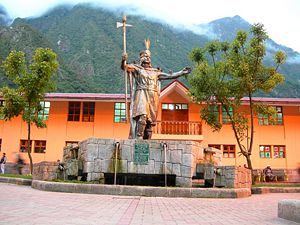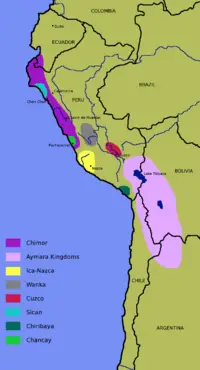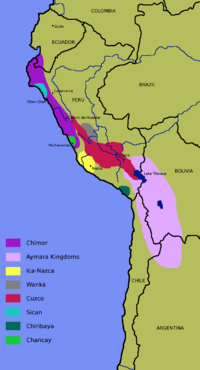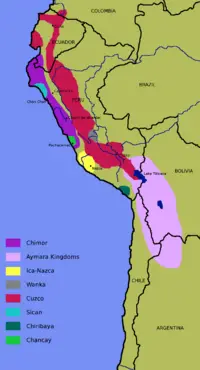Pachacuti
| Pachacuti | ||
|---|---|---|
| Sapa Inca | ||
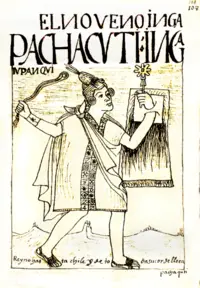
| ||
| Pachacuti as drawn by Guaman Poma | ||
| Reign | 1438 – 1471/1472 | |
| Full name | Pachacuti Inca Yupanqui | |
| Predecessor | Viracocha | |
| Successor | Túpac Inca Yupanqui | |
| Father | Viracocha | |
Pachacuti Inca Yupanqui (or Pachacutec) was the ninth Sapa Inca (1438-1471/1472) of the Kingdom of Cusco, which he transformed into the empire Tawantinsuyu. In Quechua, Pachakutiq means "He who remakes the world." During his reign, Cuzco grew from a hamlet into an empire that could compete with, and eventually overtake, the Chimu. He began an era of conquest that, within three generations, expanded the Inca dominion from the valley of Cuzco to nearly the whole of civilized South America.
Lineage
Pachacuti, son of Inca Viracocha, was the fourth of the Hanan dynasty. His wife's name is given as Mama Anawarkhi or Coya Anahurque. He had two sons: Amaru Yupanqui and Tupac Inca Yupanqui. Amaru, the older son, was originally chosen to be co-regent and eventual successor. Pachacuti later chose Tupac because Amaru was not a warrior.[1]
Succession
Pachacuti's given name was Cusi Yupanqui and he was not supposed to succeed his father Inca Viracocha who had appointed his brother Urco as crown prince. However in the midst of an invasion of Cuzco by the Chankas, the Incas' traditional tribal archenemies, Pachacuti had a real opportunity to demonstrate his talent. While his father and brother fled the scene Pachacuti rallied the army and prepared for a desperate defense of his homeland. In the resulting battle the Chankas were defeated so severely that legend tells even the stones rose up to fight on Pachacuti's side. Thus "The Earth Shaker" won the support of his people and the recognition of his father as crown prince and joint ruler.
The Ninth Sapa Inca
After his father's death Pachacuti became sole ruler of the Incan empire. Immediately he initiated an energetic series of military campaigns which would transform the small state around Cuzco into a formidable nation. His conquests in collaboration with Tupac Yupanqui (Pachacuti's son and successor) where so successful that the 9th Incan emperor is sometimes referred to as "The Napoleon of the Andes." When Pachacuti died in 1471 the empire stretched from Chile to the south and Ecuador to the north also including the modern countries of Peru and Bolivia as well as most of northern Argentina.
Pachacuti also reorganized the new empire, the Tahuantinsuyu or "the united four provinces." Under his system, there were four apos that each controlled one of four provinces (suyu). Below these governors were t'oqrikoq, or local leaders, who ran a city, valley, or mine. By the time of the Spanish conquest of Peru, each apo had around 15 t'oqrikoq below him, but we can assume there were fewer when Pachacuti first organized this system. He also established a separate chain of command for the army and priesthood to establish a system of checks and balances on power.
Pachacuti rebuilt much of Cuzco, designing it to serve the needs of an imperial city, and indeed as a representation of the empire. There was a sector of the city for each suyu, centering on the road leading to that province; nobles and immigrants lived in the sector corresponding to their origin. Each sector was further divided into areas for the hanan (upper) and hurin (lower) moieties. The Inca and his family lived in the center; the more prestigious area. Many of the most renowned monuments around Cuzco, such as the great sun temple of Coricancha or the "fortress" of Sacsayhuamán, were constructed during Pachacuti's reign.
Despite Pachacuti's political and military talents, he did not improve upon the system of choosing the next Inca. His son became the next Inca without any known dispute after Pachacuti died in 1471 due to a terminal illness, but in future generations the next Inca had to gain control of the empire by winning enough support from the apos, priesthood, and military to either win a civil war or intimidate anyone else from trying to wrest control of the empire. Pachacuti is also credited with having displaced hundreds of thousands in massive programs of relocation and resettling to occupy the remotest corners of his empire. These forced colonists where called mitimaes and represented the lowest place in the Incan social ladder. In a way the Incan imperial government was highly despotic and repressive.
Machu Picchu is believed to date to the time of Pachacuti.
Pachacuti was a poet and author of the Sacred Hymns of the Situa[2] city purification ceremony.
Legacy
Pachacuti is considered as somewhat of a national hero in modern Peru. During the 2000 Presidential elections candidate, the mestizo Indian population gave Alejandro Toledo the nickname Pachacuti.
| Preceded by: Viracocha |
Sapa Inca 1438-71 |
Succeeded by: Túpac Inca Yupanqui |
Notes
- ↑ Rostworowski. "Inca Succession". The Incas. Retrieved October 25, 2008.
- ↑ Curl. Sacred Hymns of the Situa. red-coral.net. Retrieved October 25, 2008.
ReferencesISBN links support NWE through referral fees
- Curl, John trans. Sacred Hymns of the Situa. red-coral.net. Retrieved October 25, 2008.
- Rostworowski, Maria. "Inca Succession". The Incas. Retrieved October 25, 2008.
External links
Credits
New World Encyclopedia writers and editors rewrote and completed the Wikipedia article in accordance with New World Encyclopedia standards. This article abides by terms of the Creative Commons CC-by-sa 3.0 License (CC-by-sa), which may be used and disseminated with proper attribution. Credit is due under the terms of this license that can reference both the New World Encyclopedia contributors and the selfless volunteer contributors of the Wikimedia Foundation. To cite this article click here for a list of acceptable citing formats.The history of earlier contributions by wikipedians is accessible to researchers here:
The history of this article since it was imported to New World Encyclopedia:
Note: Some restrictions may apply to use of individual images which are separately licensed.
